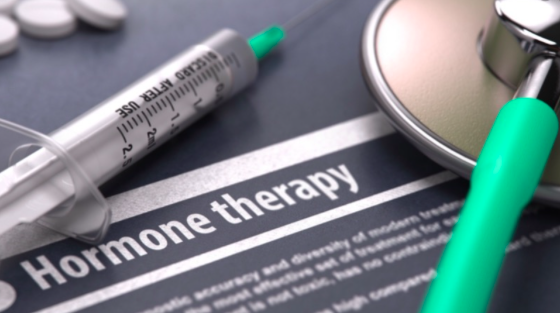|
We’ve known about the role of estrogen in breast cancer going back to the 1800s, when surgical removal of the ovaries seemed to help in some cases. Ovaries were said to send out “mysterious” influences to the rest of the body, which were identified as estrogen in 1923. The medical profession jumped on this discovery and started injecting menopausal women by the thousands, and it was said that “[t]he ‘shot’ gives a ‘respectable’ hook on which to hang the visit to the doctor…” Soon, there were pills and patches, and medical journals like the Journal of the American Medical Association regaled doctors with ads on how they can “help the women to happiness by simply prescribing estrogen” and, “[w]hen women outlive their ovaries…,” there is Premarin.
As far back as the 1940s, concerns were raised that this practice might cause breast cancer, noting it would have been nice to figure this out before we started dosing women en masse. But breast cancer risk didn’t seem to matter as much, because heart disease was the number-one killer of women, reviews concluded, and because women taking hormones appeared to have lower heart attack rates, which would outweigh any additional breast cancer. However, women taking estrogen tended to be of a higher socioeconomic class, exercised more, and engaged in other healthy lifestyle changes like consuming more dietary fiber and getting their cholesterol checked. So, maybe that’s why women taking estrogen appeared to be protected from heart disease. Perhaps it had nothing to do with the drugs themselves. Despite the medical profession’s “enthusiasm for estrogen replacement therapy,” only a randomized clinical trial could really resolve this question. We would need to divide women into two groups, with half getting the hormones and half getting a placebo, and follow them out for a few years. There was no such study…until the 1990s, when the Women’s Health Initiative study was designed.
Wait a second. Why did it take the bulk of a century to decide to definitively study the safety of something prescribed to millions of women? Perhaps because there had never been a female director of the US National Institutes of Health until then. “Just three weeks after being named NIH Director in 1991, [Bernadine Healy] went before Congress to announce, ‘We need a moon walk for women.’ That ‘moon walk’ took the form of the Women’s Health Initiative, the most definitive, far-reaching clinical trial of women’s health ever undertaken in the United States.”
The bombshell landed in summer 2002. There was so much more invasive breast cancer in the hormone users that they were forced to stop the study prematurely. What about heart disease? Wasn’t that supposed to balance things out? The women didn’t just have more breast cancer—they had more heart attacks, more strokes, and more blood clots to their lungs.
The news that women treated with hormone replacement therapy “experienced higher rates of breast cancer, cardiovascular disease, and overall harm has rocked women and physicians across the country.” Estrogen started out as the most prescribed drug in America before the study, but, after, the number of prescriptions dropped immediately and, within a year, so did the incidence of breast cancer..
The most important question about this story is — why were we all so surprised? There had been “decades of repeated warnings” about the risks of cancer. In fact, the reason breast cancer patients had so much trouble suing the pharmaceutical company was that “the drugs have contained warning labels for decades.” And, with that disclosure, surely any reasonable physician would have included it in their risk and benefit discussions with their patients, right? It’s like the warning labels on packs of cigarettes. If you get lung cancer now, you should have known better. And, so, if you were on hormone replacement therapy and got breast cancer, don’t blame the drug company. They warned you about the risks, right there in the fine print.
Why didn’t more doctors warn their patients? Even after the study came out, millions of prescriptions continued to be dispensed. “That’s a lot of cancer in our patients we caused”, wrote one doctor. “How long will it take us to discard the financial gains, to admit that we are harming many of our patients, and to start changing our prescription habits?”
“Why did this practice continue in the face of mounting evidence of harm?” Well, it is a multibillion-dollar industry. “Despite an overwhelming amount of evidence to the contrary, many physicians still believe that estrogenic hormones have overall health benefits,” a “non-evidence-based perception [that] may be the result of decades of carefully orchestrated corporate influence on medical literature.” Indeed, “[d]ozens of ghostwritten reviews and commentaries published in medical journals and supplements were used to promote unproven benefits and downplay harms of menopausal hormone therapy…” PR companies were paid to write the articles that were then passed off as having been written by some expert.
What now? “Gynecologists must switch allegiance from eminence-based to evidence-based medicine.” In other words, they must consider what the science says and not just what some so-called expert says. It’s been said that the “current culture of gynecology encourages the dissemination of health advice based on advertising rather than science.”
“Women were placed in the way of harm by their physicians, who acted as unsuspecting patsies for the pharmaceutical companies.” If we really wanted to prevent heart attacks in women, simple lifestyle behaviors can eliminate more than 90 percent of heart attack risk. So, instead of being Big Pharma’s pawns, “recommending a healthful diet, increased exercise, and smoking cessation would truly benefit women’s health.”
|

